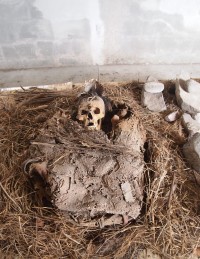A pre-Hispanic mortuary bundle had been found in a rock shelter near the town of Zimapán in the Sierra Gorda of Hidalgo, southeastern Mexico. The skeletal remains wrapped in a dyed fabric and a braided mat were discovered by locals who alerted the National Institute of Anthropology and History (INAH). INAH archaeologists examined the bundle and believe it is intact, although only the cranium with some hair still attached, tibias, clavicle, shoulder blades and some ribs are visible above the wrapping.
 The remains haven’t been dated yet. It’s the positioning of the body in a seated posture, the plant fibers used in the shroud and the placement in a rock shelter that all point to this being a pre-Hispanic burial. In many Mesoamerican cultures, rock shelters and caves were believed to be entrances to the underworld and the abode of death gods. Thus these locations were seen as ideal burial spaces. Despite the rocky terrain of the Sierra Gorda being replete with these sorts of nooks and crannies, this is the only mortuary bundle of its kind found in the state of Hidalgo.
The remains haven’t been dated yet. It’s the positioning of the body in a seated posture, the plant fibers used in the shroud and the placement in a rock shelter that all point to this being a pre-Hispanic burial. In many Mesoamerican cultures, rock shelters and caves were believed to be entrances to the underworld and the abode of death gods. Thus these locations were seen as ideal burial spaces. Despite the rocky terrain of the Sierra Gorda being replete with these sorts of nooks and crannies, this is the only mortuary bundle of its kind found in the state of Hidalgo.
Forensic anthropologists have determined from the teeth and leg bones that the deceased was about 20 years old when he or she died. The third molars, which grow in early adulthood between 16 and 24 years of age, are present but show no signs of wear. In the tibia, the epiphyseal plate, a cartilaginous plate at the end of the long bones that is replaced by bone after puberty, has hardened into bone, leaving behind the scar of the epiphyseal line. The line is still visible, however, and that fades with time, so that suggests the person died in early adulthood.
Although there does not appear to have been any preservation of soft tissues, the semi-arid climate of the eastern Sierra Gorda did help preserve the organic fibers of the wrapping. The bundle has been moved to an INAH lab where it will be studied in detail and the wrapping removed to reveal the rest of the remains. First a conservator will treat the fabric and plant fiber mat to ensure they’re not damaged in the opening. Then experts will hopefully be able to determine the sex of the deceased from the pelvic and hop bones.
INAH researchers hope the bones will tell more of the person’s history — disease, nutrition, lifestyle — as well as which culture he or she was a part of. The rock shelter is an area that saw a variety of peoples living there, nomadic and sedentary. The bones might fill in some of those blanks. The archaeological context might help on that score. Vegetation found in the soil of the rock shelter (palm leaves, agave cactus) appears to have been deliberately layered on the spot. Archaeologists also found a small group of abstract cave paintings about 550 yards from the mortuary bundle.